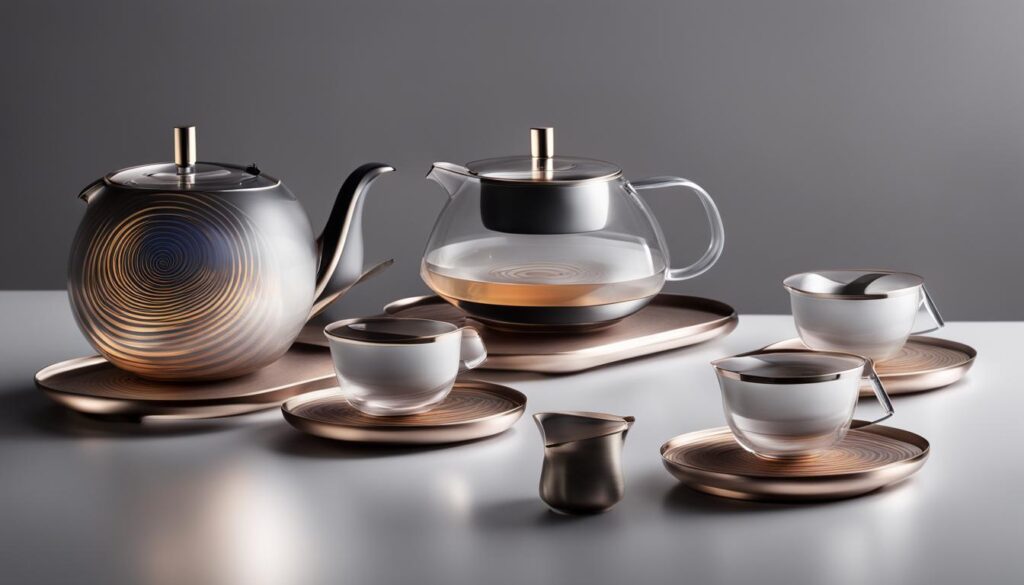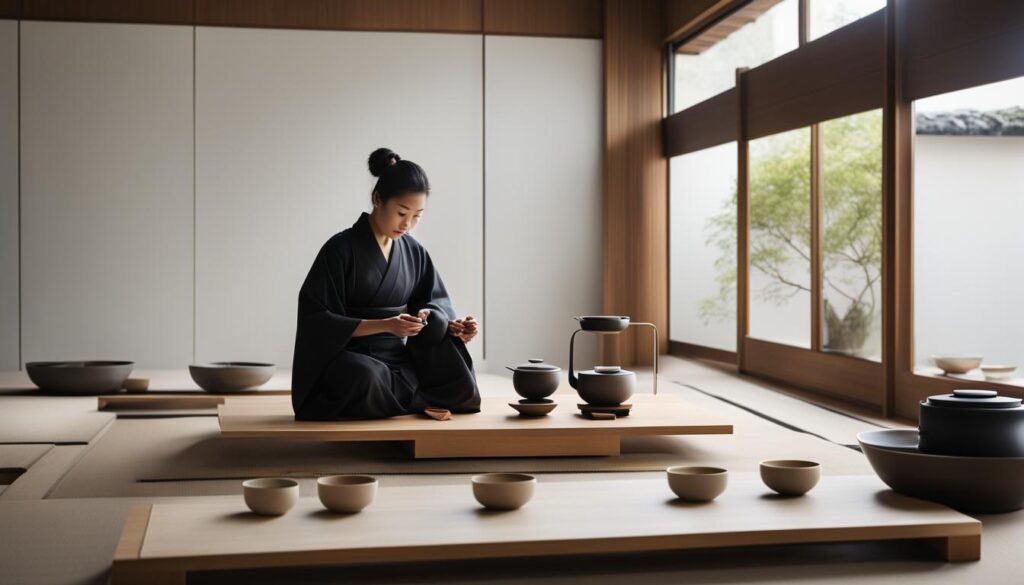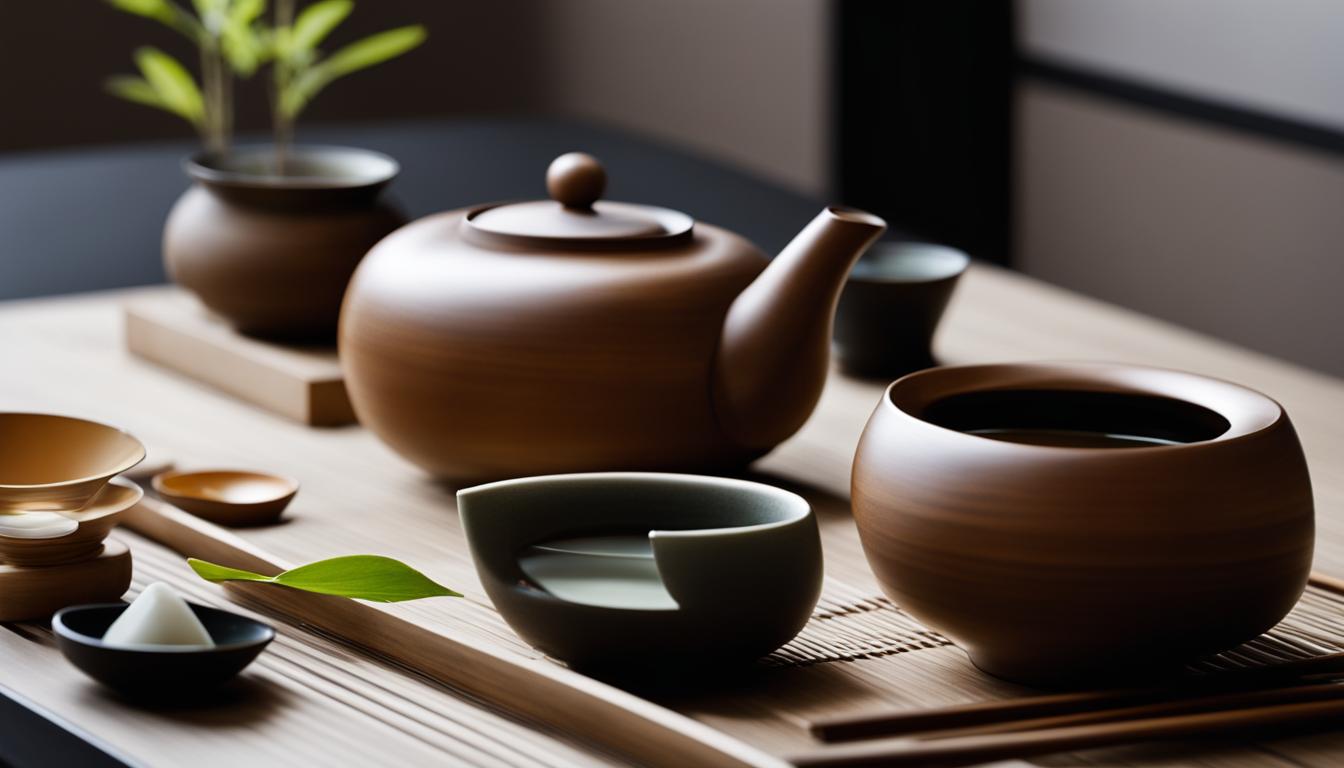Tea, the ancient elixir celebrated for its rich flavors and soothing properties, has undergone a remarkable transformation in recent times. As the world becomes increasingly interconnected, traditional tea ceremonies have evolved to embrace modern approaches, bridging the gap between ancient rituals and contemporary lifestyles. In this article, we delve into the fascinating world of modern tea ceremony interpretations and explore the fusion of tradition and innovation in the realm of tea.
Key Takeaways:
- Traditional tea ceremonies have adapted to meet the needs and preferences of the modern age.
- Contemporary tea ceremony styles blend tradition with innovation, creating a unique and dynamic tea experience.
- Advancements in technology and globalization have influenced the evolution of tea ceremonies.
- Mindfulness and appreciation for the nuanced flavors of tea remain timeless values in the modern tea brewing process.
- Modern interpretations of tea ceremonies showcase the versatility and adaptability of this ancient ritual.
Modern Interpretations of Traditional Tea Ceremonies: A New Perspective
In the modern age, tea ceremonies have evolved to incorporate new practices and techniques, blending tradition with innovation. One such example is the Gongfu Cha, a Chinese tea ceremony renowned for its fusion of traditional methods with modern elements. The Gongfu Cha places a strong emphasis on skillful brewing and the use of a small teapot called a gaiwan.
The gaiwan allows for multiple short infusions, resulting in a diverse range of flavors and aromas. This modern twist on the traditional tea ceremony showcases how tea enthusiasts have adapted the Gongfu Cha to suit the fast-paced lifestyle of the 21st century. By embracing fusion tea ceremony techniques, the Gongfu Cha continues to captivate tea aficionados with its rich history and contemporary allure.
With the Gongfu Cha, tea lovers can indulge in the art of precise tea brewing while savoring the nuanced flavors that unfold through each infusion. The Chongfu Cha, or “repeat infusion,” technique is a hallmark of the Gongfu Cha. It involves steeping the tea leaves multiple times, allowing for a gradual release of flavors and a captivating sensory experience.
| Key Aspects of the Gongfu Cha: | Benefits of Fusion Tea Ceremony Techniques: |
|---|---|
| Skillful brewing | Offers a modern twist on traditional tea ceremonies |
| Use of gaiwan for short infusions | Allows for a diverse range of flavors and aromas |
| Chongfu Cha technique | Provides a captivating sensory experience |
The Gongfu Cha exemplifies how tea ceremonies have transformed over time, blending tradition with the demands of modern life. By embracing fusion tea ceremony techniques, this ancient practice remains relevant and appealing to tea enthusiasts in the 21st century.
The Japanese Tea Ceremony: The Way of Tea
In the world of tea ceremonies, the Japanese Tea Ceremony, known as Chanoyu, stands as a notable example of blending tradition and modernity. It is a choreographed ritual that embodies harmony, respect, purity, and tranquility. The principles of Zen Buddhism are reflected in every aspect of the ceremony, from the preparation of ceremonial matcha to the design of the tea room itself.
The Japanese Tea Ceremony is a celebration of sensory experience and mindfulness. The process of preparing and serving matcha requires patience, precision, and an unwavering focus on the present moment. Every movement is deliberate and symbolic, creating a sense of profound connection with oneself and others.
“The Japanese Tea Ceremony is a unique blend of tradition and aesthetics. It offers a serene escape from the noise and chaos of the modern world, inviting participants to slow down and appreciate the beauty of simplicity.”
The modern adaptation of the Japanese Tea Ceremony showcases contemporary design principles while honoring ancient traditions. Traditional tea rooms, called chashitsu, are often integrated into modern architectural designs, blending elements of minimalism and natural materials. The use of clean lines, organic shapes, and subdued colors creates a calming atmosphere, allowing participants to immerse themselves fully in the tea ceremony experience.
From the precise angles of the tea utensils to the carefully curated seasonal decorations, every detail in the Japanese Tea Ceremony is intentional. The combination of traditional elements with modern design aesthetics demonstrates the adaptability of tea ceremonies in contemporary culture.
Yerba Mate: A South American Communal Ritual Adapted for the Modern Age
Yerba mate, a traditional South American drink, holds deep cultural significance as a communal ritual symbolizing unity and friendship. Traditionally, it is consumed from a hollowed-out gourd using a metal straw known as a bombilla. However, in the 21st century, yerba mate has undergone adaptations to suit the needs and preferences of modern culture.
One of the notable adaptations is the availability of ready-to-drink bottled yerba mate. This convenient option allows individuals to enjoy the energizing effects of yerba mate without the traditional communal experience. Whether on-the-go or in a fast-paced urban setting, bottled yerba mate offers a quick and accessible way to partake in this age-old ritual.
Additionally, yerba mate has been incorporated into various modern beverage creations, showcasing its versatility in contemporary culture. Popular cafes and tea houses now offer yerba mate lattes and blends infused with different flavors. These innovative combinations cater to individuals seeking unique and refreshing alternatives while embracing the rich legacy of yerba mate.
“Yerba mate brings people together, transcending borders and creating connections. Its adaptability in the modern age allows us to experience the spirit of camaraderie in new and exciting ways.”
A Comparison of Traditional and Modern Yerba Mate Consumption
| Traditional Yerba Mate | Modern Yerba Mate |
|---|---|
| Consumed from a hollowed-out gourd | Available in ready-to-drink bottled form |
| Shared among a group of people | Individually enjoyed |
| Traditional preparation with a bombilla | Convenient, no preparation required |
| Symbolizes unity and friendship | Retains the essence of camaraderie in a modern context |
While some purists may argue that these adaptations dilute the essence of traditional yerba mate consumption, they provide new avenues for individuals to connect with this centuries-old tradition. The ability to enjoy yerba mate in various forms ensures its continued relevance and popularity in the 21st century.
Innovations in Traditional Tea Ceremonies: A Modern Twist on Tradition
Tea ceremonies have long been revered for their cultural significance and spiritual qualities. However, in the modern age, these traditional practices have undergone innovative transformations, blending tradition with contemporary elements. From the fusion of British milk tea with Hong Kong-style milk tea to the popularization of bubble tea in Taiwan, tea cultures from around the world have come together to create exciting and unique experiences.
This blending of tea cultures reflects the changing values and preferences of today’s tea enthusiasts. It showcases how tea ceremonies have evolved to adapt to the fast-paced, convenience-driven lifestyles of the 21st century. While some may argue that these modern interpretations dilute the essence of traditional tea rituals, they can also be seen as a testament to the global evolution of tea and its ability to bring people together in new and unexpected ways.

The Global Fusion of Tea Cultures
One notable innovation in the modern tea ceremony scene is the incorporation of different tea cultures from around the world. Traditional Chinese, Japanese, and South American tea rituals have been reimagined to create unique and enticing experiences. These modern twists on traditional tea ceremonies attract a diverse range of tea enthusiasts, offering them a chance to explore new flavors and rituals.
| Traditional Tea Ceremony | Modern Twist |
|---|---|
| Chinese Gongfu Cha with Gaiwan and multiple short infusions | Chongfu Cha – fusion of traditional techniques with modern elements |
| Japanese Tea Ceremony with ceremonial matcha | Contemporary tea ceremony design – blending tradition and modernity |
| South American Yerba Mate communal ritual | Adaptation for the modern age – individual enjoyment without communal experience |
These innovations demonstrate the versatility and adaptability of tea ceremonies, as they continue to evolve and captivate tea enthusiasts worldwide. The blending of tradition and modernity in tea cultures not only adds excitement to the tea-drinking experience but also provides an avenue for cultural exchange and appreciation.
As tea continues to reinvent itself in the modern age, these innovative interpretations of traditional tea ceremonies remind us that the essence of tea lies not only in its ancient customs but also in its ability to adapt to the changing world around us.
The Value of Mindfulness in Modern Tea Brewing
Tea ceremonies have undergone significant changes in the modern age, with traditional rituals adapting to the fast-paced lifestyle of today. However, amidst these adaptations, there is still immense value in embracing mindfulness in the process of brewing and consuming tea. By taking a more mindful approach, we can find solace and connection in the midst of our busy lives.
Mindfulness is about being fully present and aware in the current moment. When it comes to tea brewing, this means slowing down and appreciating each step of the process. From carefully selecting the tea leaves to pouring the hot water and observing the color and aroma, mindfulness allows us to savor every aspect of the tea experience.
By cultivating mindfulness in tea brewing, we can enhance our overall well-being. Research has shown that mindfulness practices have numerous benefits, including reducing stress, improving focus, and promoting a sense of inner calm. Incorporating mindful tea rituals into our daily routine provides a moment of respite and allows us to recharge and reconnect with ourselves.
Furthermore, mindfulness in tea brewing fosters a deeper appreciation for the flavors and aromas of tea. By paying attention to the subtleties and intricacies of each sip, we can truly savor the complex and diverse range of flavors that tea has to offer. This heightened sensory experience adds an extra layer of enjoyment to our tea rituals, making them more meaningful and enriching.
Incorporating mindfulness into our modern tea ceremonies allows us to strike a balance between tradition and contemporary lifestyle. While convenience-driven practices have their place, embracing mindfulness brings us back to the essence of tea ceremonies – a moment of tranquility, connection, and self-reflection. So, let us take a moment to slow down, savor our tea, and find peace in the present moment.
The Evolution of Tea Brewing Methods in the Modern World
Tea brewing methods have undergone a significant transformation in the modern world, blending traditional practices with contemporary styles. As tea enthusiasts seek convenience and cater to individual preferences, a variety of innovative approaches have emerged. From automated electric tea kettles to instant chai powders, these adaptations reflect the changing needs and desires of today’s tea lovers.
Contemporary Tea Ceremony Styles
One notable development is the incorporation of modern technology into tea ceremonies. Automated electric tea kettles, equipped with settings for multiple quick infusions, offer a convenient way to brew tea while maintaining the essence of traditional practices. These kettles ensure precise temperature control and brewing times, allowing tea enthusiasts to enjoy a perfect cup every time. The fusion of technology and tradition exemplifies the evolving nature of tea ceremonies in the modern age.
Additionally, the rise of matcha lattes highlights a contemporary twist on the Japanese Tea Ceremony. Electric frothers are used to create a creamy texture, complementing the bitter notes of matcha with the smoothness of milk. This modern take on a traditional ritual appeals to those seeking a unique and flavorful tea experience. It showcases how tea ceremonies can adapt to modern tastes and preferences while staying rooted in their cultural heritage.
Tea Ceremonies Blending Tradition and Modernity
Another aspect of the evolution of tea brewing methods is the availability of pre-blended teas with spices and flavors. These offerings cater to individuals looking for quick and easy ways to enjoy their tea without compromising on taste. By providing a convenient alternative to traditional brewing methods, these pre-blended teas embrace the concept of tea ceremonies in the modern world. They allow individuals to experience the richness of tea culture while fitting it seamlessly into their busy lives.
In conclusion, the evolution of tea brewing methods in the modern world showcases the blending of tradition and modernity. From automated electric kettles and matcha lattes to pre-blended teas, tea ceremonies have adapted to meet the needs and desires of contemporary society. These innovative approaches not only offer convenience but also provide a platform for tea enthusiasts to explore and appreciate the diverse and nuanced flavors of tea. As tea continues to evolve, it remains a timeless and cherished ritual in our ever-changing world.

Conclusion
As we conclude our exploration of modern tea ceremony interpretations, it becomes clear that these ancient rituals have gracefully adapted to meet the needs of the modern age. While some may argue that these interpretations dilute the essence of traditional tea ceremonies, we believe they showcase the timeless appeal and versatility of this age-old ritual.
From the fusion of traditional techniques with modern elements in the Gongfu Cha to the blending of traditional elements with a modern design aesthetic in the Japanese Tea Ceremony, tea ceremonies have found harmony between tradition and modernity.
While convenience-driven innovations have emerged, such as automated electric tea kettles and instant chai powders, the value of mindfulness in tea brewing remains steadfast. The traditional emphasis on patience, mindfulness, and community reminds us of the importance of slowing down and appreciating the nuanced flavors of tea in our fast-paced world.
In the end, we believe that both modern and traditional interpretations of tea ceremonies have their place. These adaptations reflect the evolving values and preferences of tea enthusiasts, offering a wide range of options for those seeking a connection with tea in the modern age.
FAQ
How have traditional tea ceremonies evolved in the modern age?
Traditional tea ceremonies have evolved by incorporating modern elements and adapting to fit into the fast-paced, modern lifestyle.
What is the Gongfu Cha tea ceremony?
The Gongfu Cha tea ceremony originated in China and emphasizes brewing tea with skill and precision. It involves using a small teapot called a gaiwan for multiple short infusions, resulting in a range of nuanced flavors.
What is the Japanese Tea Ceremony?
The Japanese Tea Ceremony, known as Chanoyu, is a choreographed ritual that embodies harmony, respect, purity, and tranquility. It involves the preparation and serving of ceremonial matcha and reflects the principles of Zen Buddhism.
How has yerba mate, a traditional South American drink, been adapted for the modern age?
Yerba mate, traditionally consumed from a hollowed-out gourd using a metal straw, has been adapted to fit modern lifestyles. Ready-to-drink bottled versions are available, allowing individuals to enjoy yerba mate without the traditional communal experience.
How have different tea cultures blended together in the modern age?
With advancements in technology and globalization, various tea cultures have fused together. British Milk tea has found its way into Hong Kong-style milk tea and Taiwan’s popular “bubble tea,” showcasing the global evolution of tea.
Is there still value in adopting a mindful approach to tea?
Yes, despite modern adaptations, adopting a mindful approach to tea can provide a deeper connection with oneself and the world around us. Traditional rituals emphasize patience, mindfulness, and community.
What brewing methods are popular in the modern world?
Automated electric tea kettles, matcha lattes made with electric frothers, and instant chai powders are popular brewing methods that cater to the convenience and preferences of tea enthusiasts in the 21st century.
What is the overall significance of modern tea ceremony interpretations?
Modern interpretations of tea ceremonies demonstrate the timeless appeal and versatility of this ancient ritual in the modern age, adapting to meet the needs and desires of contemporary society.





